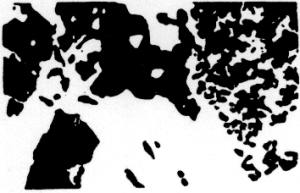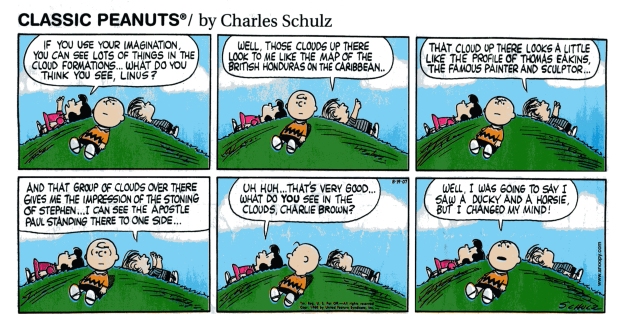A piece in Psychology Today (July 29, 2012) by Neel Burton in their ‘hide & Seek’ column: The Creation of God: Michelangelo’s awesome hidden message. http://www.psychologytoday.com/blog/hide-and-seek/201207/the-creation-god
It’s an analysis of Michaelangelo’s famous picture from the Sistine chapel ‘The Creation of Adam’ (http://en.wikipedia.org/wiki/File:Creaci%C3%B3n_de_Ad%C3%A1n.jpg) claiming to show that “what almost everyone has missed is the hidden message that Michelangelo inserted: a human brain dissimulated in the figure of God.”
Although the Creation of Adam was painted around 1511, it is not until 1990 that Frank Lynn Meshberger, a physician in Anderson, Indiana, publicly noted in the Journal of the American Medical Association that the figures and shapes that make up the figure of God also make up an anatomically accurate figure of the human brain. Take a close look at the picture above and you will see the Sylvian fissure that divides the frontal lobe from the parietal and temporal lobes: it is represented by a bunching up of the cape by one of the angels and by a fold in God’s tunic. The bottom-most angel that appears to support the weight of God is the brainstem, and his trailing scarf the vertebral artery. The foot of another angel is the pituitary gland, and his bent knee the optic chiasm where the optic nerves from the eyes partially cross over. The ingenuity and level of detail is simply staggering, and a lasting testament to Michelangelo’s extraordinary—and, for the time, very unusual—knowledge of human anatomy.
Yeah, right. Take another look and you’ll see that if it is an image of the brain, then the cerebellum has been blown to ribbons, and there’s a very unhealthy-looking overdevelopment of the occipital lobe at the back of the brain. Also most of God’s body is in the midbrain, with a bit of His head sticking through into the frontal lobes. Given that God is the primary image in the right-hand cloud, what was M’s meaning in slicing up his body so randomly amongst different brain areas, given his “extraordinary—and, for the time, very unusual—knowledge of human anatomy”?
I think this is just another example of the powerful and compelling ability we have to extract meaningful information from very complex or confusing input – which sometimes leads us to ‘see’ clearly things which just aren’t there. You will have heard of images of the Virgin Mary on pieces of toast, or sliced tomatoes (I regularly see Lao Tsu in my porridge).
An old example is this image:

Said to be originally a photograph of a snowy mountainside, but ‘revealing’ an image of a bearded man with long hair (some say Christ, some say Gerry Garcia: it’s probably Allen Ginsberg) if you look at it long enough. If you don’t see it,don’t worry. The face will pop out at you sooner or later, and once you’ve seen it, you won’t be able to go back to the meaningless blobs.
We all do this kind of thing with clouds, as Shakespeare noted some time ago:
Hamlet: Do you see yonder cloud that’s almost in shape of a camel?
Polonius: By the mass, and ’tis like a camel, indeed.
Hamlet: Methinks it is like a weasel.
Polonius: It is backed like a weasel.
Hamlet: Or like a whale?
Polonius: Very like a whale.
— Hamlet, III.ii
OK, this is Hamlet mocking Polonius for always agreeing with what the boss says, but it only makes sense because we all know that we can see all kinds of things in the complex, ambiguous patterns of clouds.
Charles Schultz used the idea too, in Peanuts:

In case you can’t read the speech bubbles above,or the image link stops working:
Lucy Van Pelt: Aren’t the clouds beautiful? They look like big balls of cotton. I could just lie here all day and watch them drift by. If you use your imagination, you can see lots of things in the cloud’s formations. What do you think you see, Linus?
Linus Van Pelt: Well, those clouds up there look to me look like the map of the British Honduras on the Caribbean. [points up] That cloud up there looks a little like the profile of Thomas Eakins, the famous painter and sculptor. And that group of clouds over there… [points] …gives me the impression of the Stoning of Stephen. I can see the Apostle Paul standing there to one side.
Lucy Van Pelt: Uh huh. That’s very good. What do you see in the clouds, Charlie Brown?
Charlie Brown: Well… I was going to say I saw a duckie and a horsie, but I changed my mind.
So, I think Neel Burton is wrong – and I think he’s missed an even more remarkable clue: God is passing the spark of life from his finger to Adam – just like the spark of life which ignites the petrol/air mixture in the combustion chamber of the petrol engine (M. did actually do drawings of a flat-four hemihead air-cooled engine, intended to power his famous helicopter, but they were lost in the 19th century). So every time I fire up the Bristol, I reflect on M’s secret message about the true meaning of life.
If you really want to get into the ‘M’s secret messages’ stuff, here’s Orion in the Vatican by Daniel A. Wilten, an online book (only $9.99): http://www.orioninthevatican.com/
Witness the Orion nebula hidden in high altars and in famous frescoes by masters such as Michelangelo since the early 1500’s
Discover the famous fresco depicting the Orion constellation in the main vault of the mother Jesuit church
Discover the true origin of the winged disk and where the ancients derived its symbolism
Learn why Hermes Trismegistos declared Egypt the image of heaven
See proof of the Hall of Records and the Orion nebula matching recent development in Egypt
Resdiscover mystical knowledge uncovered after thousands of years
Learn man’s connection to the Orion nebula and its association to consciousness
Learn why the Orion nebula is the master code
*Not a psychologist, actually. Psychology Today says: “Neel Burton, M.D., is a psychiatrist, philosopher, and writer who lives and teaches in Oxford, England.”

